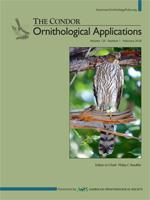Wind power is a fast-growing energy resource, but wind turbines can kill volant wildlife, and the flight behavior of obligate soaring birds can place them at risk of collision with these structures. We analyzed altitudinal data from GPS telemetry of critically endangered California Condors (Gymnogyps californianus) to assess the circumstances under which their flight behavior may place them at risk from collision with wind turbines. Condor flight behavior was strongly influenced by topography and land cover, and birds flew at lower altitudes and closer to the rotor-swept zone of wind turbines when over ridgelines and steep slopes and over forested and grassland cover types. Condor flight behavior was temporally predictable, and birds flew lower and closer to the rotor-swept zone during early morning and evening hours and during the winter months, when thermal updrafts were weakest. Although condors only occasionally flew at altitudes that placed them in the rotor-swept zone of turbines, they regularly flew near or within wind resource areas preferred by energy developers. Practitioners aiming to mitigate collision risk to this and other soaring bird species of conservation concern can consider the manner in which flight behavior varies temporally and in response to areas of high topographic relief and proximity to nocturnal roosting sites. By contrast, collision risk to large soaring birds from turbines should be relatively lower over flatter and less rugged areas and in habitat used during daytime soaring.
How to translate text using browser tools
11 April 2018
Flight response to spatial and temporal correlates informs risk from wind turbines to the California Condor
Sharon A. Poessel,
Joseph Brandt,
Laura Mendenhall,
Melissa A. Braham,
Michael J. Lanzone,
Andrew J. McGann,
Todd E. Katzner
ACCESS THE FULL ARTICLE

The Condor
Vol. 120 • No. 2
May 2018
Vol. 120 • No. 2
May 2018
flight altitude
Gymnogyps californianus
land cover
landform
soaring
topographic roughness
wind energy development




